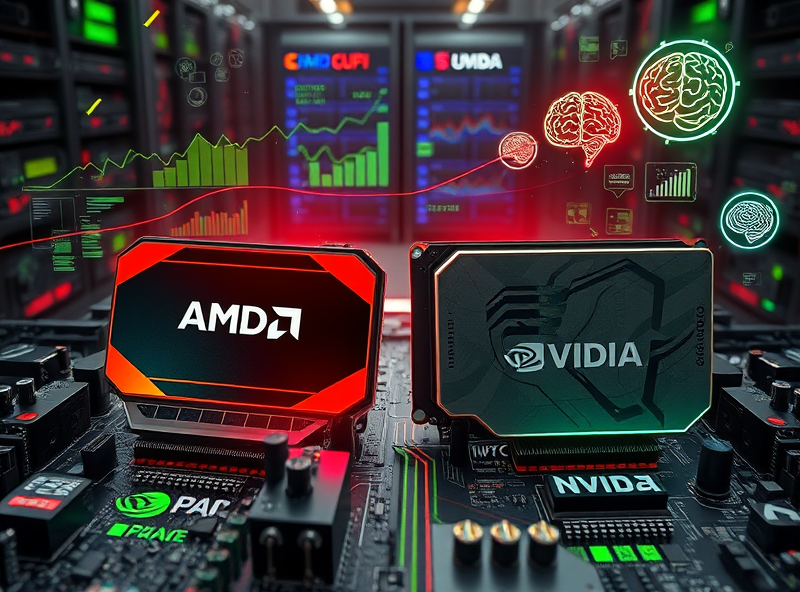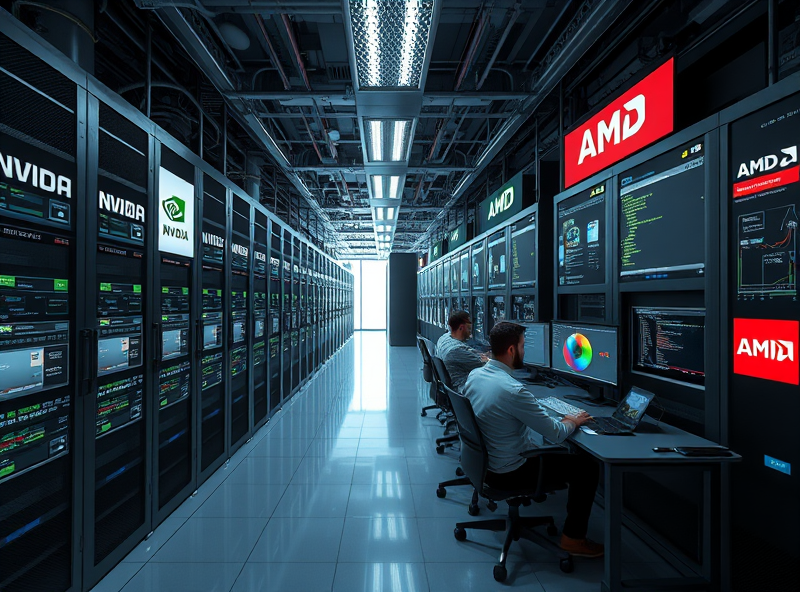
Can AMD Challenge NVIDIA in AI Chips?
AMD’s Strength in AI Inference Performance

As the AI hardware landscape continues to evolve, AMD is emerging as a serious contender in the AI inference space—a domain where real-time processing of trained AI models is crucial. While NVIDIA has long dominated the AI chip market, especially in training large models, AMD is making significant strides in inference performance, offering compelling alternatives for developers and enterprises alike.
One of AMD’s key strengths lies in its ROCm (Radeon Open Compute) software stack, which has matured rapidly and now supports popular AI frameworks like PyTorch and TensorFlow. This compatibility makes it easier for developers to transition from NVIDIA-based environments. Additionally, AMD’s MI300 series accelerators, particularly the MI300X, are optimized for inference workloads, offering high memory bandwidth and large on-chip memory—both critical for running large language models (LLMs) efficiently.
Another advantage is AMD’s cost-performance ratio. For organizations looking to scale AI services without incurring the high costs associated with NVIDIA’s premium GPUs, AMD offers a more budget-friendly yet powerful alternative. This is especially beneficial for edge computing and cloud service providers who prioritize inference tasks over training.
Moreover, AMD is actively collaborating with major cloud providers like Microsoft Azure and Oracle Cloud to integrate its AI accelerators into their infrastructure. This ensures that more developers can access AMD-powered environments for AI inference tasks, broadening its ecosystem and encouraging innovation.
In summary, while NVIDIA still leads in AI training, AMD is carving out a strong position in AI inference. Its combination of hardware innovation, software support, and cost efficiency makes it a valuable option for businesses aiming to deploy AI solutions at scale.
For more technical details on AMD’s ROCm platform, you can visit the official site: https://rocmdocs.amd.com/
Cost-Effective Advantage and Product Innovation

As the AI chip market rapidly expands, AMD is emerging as a serious contender to NVIDIA, especially when it comes to cost-effectiveness and innovation. While NVIDIA has long dominated the AI hardware space with its CUDA ecosystem and powerful GPUs, AMD is making strategic moves that could shift the balance.
One of AMD’s biggest advantages lies in its pricing strategy. AMD’s MI300 series, particularly the MI300X, offers competitive AI inference performance at a significantly lower cost compared to NVIDIA’s H100. This makes AMD an attractive option for startups and enterprises looking to scale AI workloads without overspending. In a time when companies are seeking to optimize their AI infrastructure budgets, AMD’s cost-per-performance ratio is hard to ignore.
In addition to affordability, AMD is pushing forward with product innovation. The MI300X is built on AMD’s CDNA 3 architecture and supports large memory bandwidth, which is essential for handling large language models (LLMs) and generative AI tasks. AMD has also focused on open software ecosystems like ROCm, which is increasingly gaining traction as a viable alternative to NVIDIA’s CUDA. This open approach fosters broader developer engagement and reduces vendor lock-in, which is a major concern for many organizations.
Furthermore, AMD’s recent partnerships with major cloud providers like Microsoft Azure and Meta signal growing industry confidence in its AI hardware. These collaborations not only validate AMD’s technological capabilities but also ensure that its chips are being integrated into real-world AI applications at scale.
In summary, AMD’s combination of lower cost, strong performance, and commitment to open innovation positions it as a formidable challenger to NVIDIA in the AI chip space. For businesses and developers seeking scalable, cost-efficient AI solutions, AMD is becoming an increasingly compelling choice.
For more technical details, you can refer to AMD’s official MI300X product page: https://www.amd.com/en/products/accelerators/instinct-mi300x
Challenges in Training and Software Ecosystem

As AMD seeks to compete with NVIDIA in the AI chip market, one of the most significant hurdles lies in the training phase of AI models and the surrounding software ecosystem. While AMD has made notable progress in hardware performance, particularly with its MI300 series, the software stack remains a critical bottleneck.
Training large AI models like GPT or image recognition networks requires not only powerful GPUs but also mature, optimized software frameworks. NVIDIA’s CUDA platform has been the industry standard for over a decade, offering deep integration with popular machine learning libraries such as TensorFlow and PyTorch. This gives developers a seamless experience and robust performance optimization tools.
In contrast, AMD’s ROCm (Radeon Open Compute) platform is still catching up. Although ROCm has improved significantly in recent years, it lacks the same level of community support, documentation, and third-party tool integration. This makes it harder for AI researchers and developers to transition their workloads from NVIDIA to AMD without facing compatibility or performance issues.
Another challenge is ecosystem inertia. Most existing AI infrastructure, from data centers to research labs, is already built around NVIDIA hardware and software. Convincing organizations to switch requires not just performance parity, but a compelling reason in terms of cost, energy efficiency, or unique capabilities.
However, there is hope. AMD is investing heavily in software development and open-source collaboration. Partnerships with companies like Hugging Face and improvements in ROCm compatibility with PyTorch are steps in the right direction. If AMD can continue to close the software gap and offer competitive pricing, it could become a viable alternative in the AI training space.
For a deeper look into AMD’s ROCm platform, you can visit the official site: https://rocmdocs.amd.com/
Future Outlook: Can AMD Close the Gap?

As the AI chip market continues to expand rapidly, AMD is making bold moves to close the gap with NVIDIA, the current industry leader. While NVIDIA has dominated the AI space with its CUDA ecosystem and high-performance GPUs like the A100 and H100, AMD is strategically positioning itself to compete through its MI300 series and ROCm software stack.
One of AMD’s most promising developments is the MI300X, a data center GPU designed specifically for AI workloads. With 192GB of HBM3 memory and support for large language models (LLMs), it’s a strong contender for inference and training tasks. AMD is also working closely with major cloud providers like Microsoft Azure to integrate its GPUs into AI infrastructure, a move that enhances its credibility and reach.
Moreover, AMD’s open-source ROCm platform is becoming more mature, offering developers an alternative to NVIDIA’s proprietary CUDA. While CUDA still holds a significant advantage in terms of ecosystem and developer support, ROCm’s improvements are narrowing the gap, especially for organizations seeking open standards and flexibility.
Looking ahead, AMD’s success will depend on continued investment in software, tighter integration with AI frameworks like PyTorch and TensorFlow, and partnerships with AI startups and hyperscalers. If AMD can maintain its momentum and address software compatibility challenges, it could become a viable alternative in the AI chip race.
For more technical insights, you can explore AMD’s official MI300X product page: https://www.amd.com/en/products/instinct-mi300x





